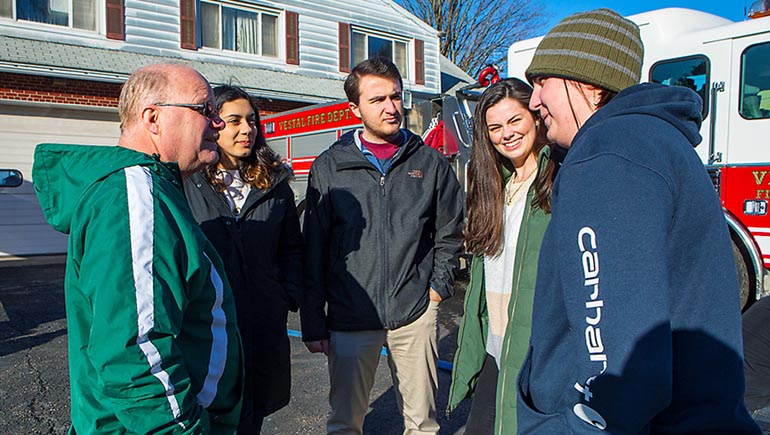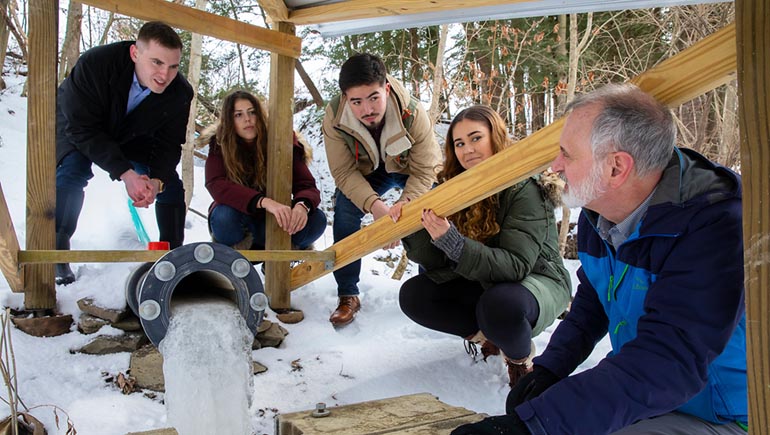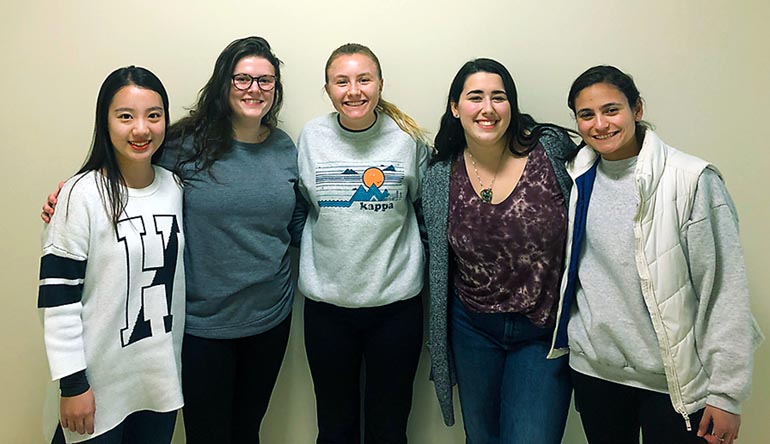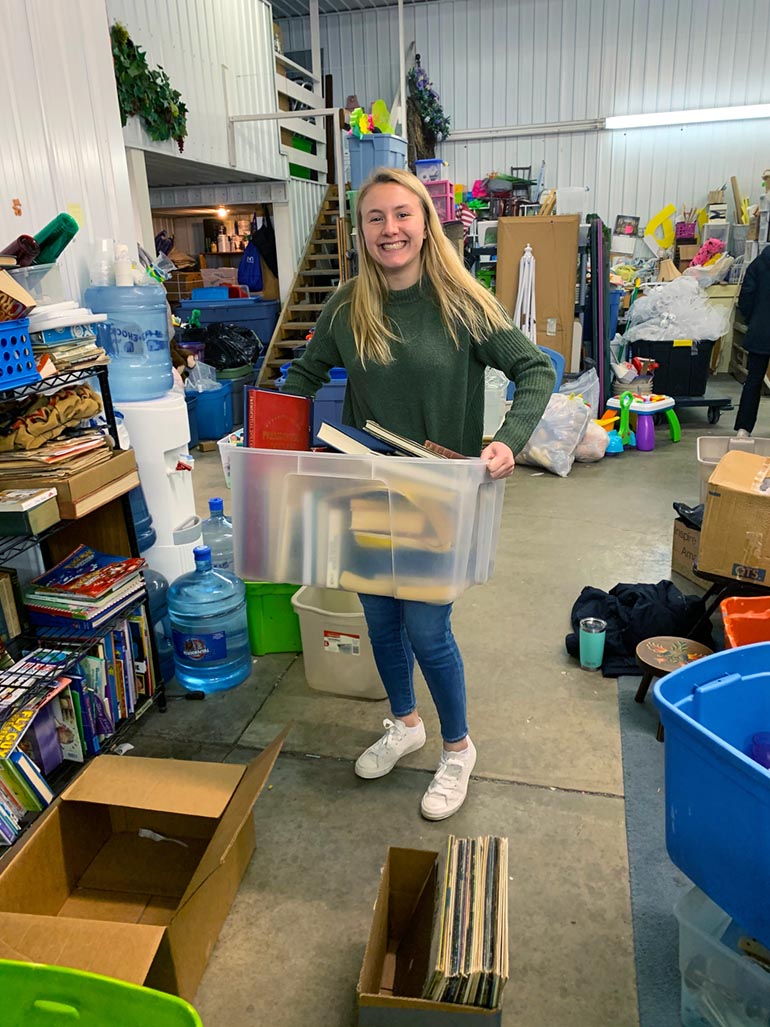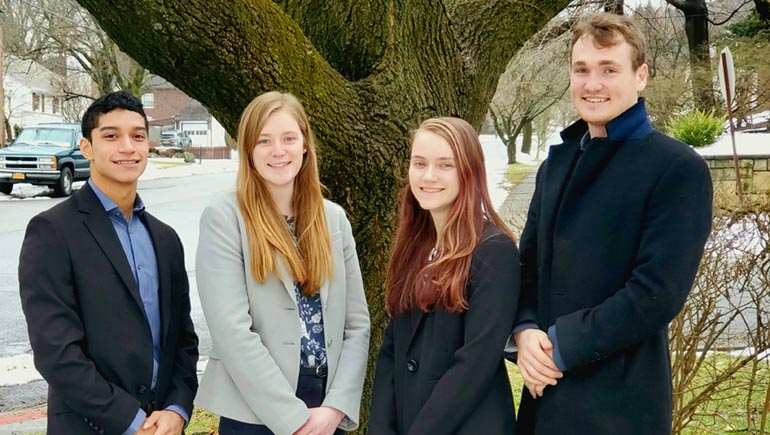Senior Standouts: Capstone projects put Watson students’ skills to the test
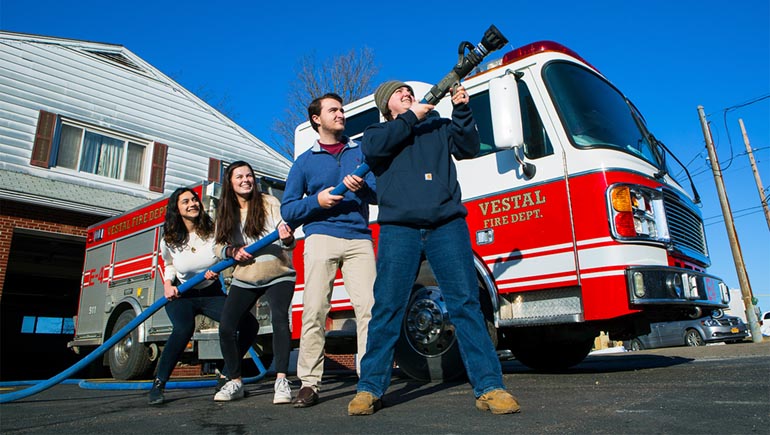
Before earning diplomas, many Watson undergraduates need to complete senior capstone projects offering real-world challenges.
Teams are four to six students each, often grouped across departments or sometimes even other schools depending on what skills are needed.
Here are interesting projects from each Watson department this academic year (except for computer science, which does not have a capstone requirement).
MECHANICAL ENGINEERING
Faculty advisor: Associate Professor Roy McGrann
Students: Katherine Frey, Maurice Grossman, Mikayla Morgan, Audrey Nieuwenhuizen, Brian Walsh (all ME)
Every adrenaline-pumping second is critical in fighting a fire, and water-stopping hose kinks can cause firefighters to lose time when trying to save lives.
One ME design team created a fire hose that prevents kinks. The project came from Watson alumnus Darran Handshaw ’07, who is the assistant fire chief for the Sound Beach Fire Department on Long Island. Handshaw proposed the idea to McGrann, who was his professor while at Binghamton.
Morgan, a team member who was a lieutenant at the West Endicott Fire Department, knows that kinks are challenging: “Most of the time, if there’s an active fire, you can’t see. You can’t always turn around. You only know if you have a kink if you get to the fire, open up the hose and no water is coming out.”
Frey says that hands-on experience with the Vestal Fire Department and West Endicott Fire Department was critical to figuring out in what conditions or angles a fire hose will kink: “They brought us to their training post and showed us physically what happens when a fire hose wraps around stairs.”
The group utilized the information to create multiple 3D prototypes. “Any and all ideas were on the table, even the ones that were improbable, just to see where we could go,” Nieuwenhuizen says.
After experimenting, the team came to a simple yet effective design. Kinks are prevented through a water-pressurized spiral that surrounds the main compartment of the fire hose and creates a rigid barrier when the hose bends.
It can be used with existing fire trucks, which Walsh says was a major design constraint: “The fire hose needs to be rigid enough so that it prevents kinking, but also flexible enough that afterward you can put it back on the truck.”
Classes on 3D modeling, heat transfer and fluid dynamics helped to bring their design to life.
“It allowed me to see things from a different perspective,” Grossman says.
—Michael Kuhl
ELECTRICAL AND COMPUTER ENGINEERING
Faculty advisor: Jack Maynard
Students: Kate Boyle, Kayla Hackett, Stephen West (electrical engineering), Chloe Carlson (environmental science), Aaron Spaulding (computer engineering)
Some senior projects are more permanent than others. All are showcased at the end of each academic year, but some ideas are recycled in future years.
This ECE project, however, will serve an educational function in a distinctive location.
West and his teammates designed and implemented a hydroelectric storage and monitoring system at Nuthatch Hollow, a once-private summer home turned bird sanctuary
that has become a resource for the University. Soon, Nuthatch Hollow will have the 13th completed Living Building in the world, a performance standard indicating it produces more energy and clean water than it uses, and that it disposes of more waste than it generates.
Carlson says: “None of the otherLiving Building projects have a turbine like the one we’re designing. Our work is part of the bigger picture, and it’s definitely something to be proud of.”
The hydropower system, under the supervision of Professor Joseph Graney from Harpur College’s Department of Geological Sciences and Environmental Studies, will be near the main pond. Graney envisions a trail adjacent to the pond, with electrical outlets along its walkways.
One requirement of the hydroelectric system is the capability to charge a MacBook Pro for up to 12 hours. Ideally, future students can work for long periods outside without having to find an indoor electrical outlet.
Boyle says: “Nuthatch Hollow is meant to be an educational facility, teaching about environmental sustainability, and this is a little example about what hydropower would be.”
Maynard believes the project and others like it have serious implications: “You can’t achieve total reusability across the world’s population.But if you’ve seen a little bit of it, it is always on your mind to say, regardless of whatever project you are working on, ‘How can we make it a little more renewable? A little more sustainable?’”
—Kyle Polidore
SYSTEMS SCIENCE AND INDUSTRIAL ENGINEERING
Faculty advisor: James Henenlotter
Students: Megan Coles, Lynn Edwards, Stephanie Ragusa, Rachel Russo, Yingyu Chen (all SSIE)
When choosing their senior project, a quintet of indus- trial engineering students sought an assignment that would positively affect a community.
Rather than work with professors on campus or in a corporate manufacturing environment, they collaborated with Susquehanna Interfaith (SI) in Montrose, Pa. In addition to running a thrift store, the nonprofit manages aid programs, including flood relief and a back-to-school shoe program.
“They have programs for victims of domestic violence,” Edwards says. “These women can pick out clothing and start fresh. Susquehanna Interfaith gives back without making people pay.”
SI is preparing for its second change of location. Cindy Beeman, SI’s executive director, explains that the move into its current facility accommodated individuals with disabilities, while the finances behind the next move will mean more money to help others.
“Susquehanna Interfaith is a very important part of the local community,” Henenlotter says. “This project allowed the students to ‘give back’ while also developing some real-world project management skills.”
The team designed a system for SI’s new facility that cuts costs, increases efficiency and minimizes downtime, Stephanie Ragusa says: “When they moved into their current facility two years ago, they had to close for a month. They weren’t accepting any donations for a month, and I don’t think Cindy wants that again.”
Designing the system meant under- standing SI’s needs, so the team spent time at the current facility.
“We volunteered to see how the volun- teers are used to everything flowing in,” Edwards says. “When they move to the new facility, with our design, it won’t be a complete shock.”
Beeman speaks glowingly of the work from the SSIE team. She notes their unique perspectives as both engineers and young consumers: “I’m really excited that they had the chance to come in and work with us. I’m hoping to increase our partnership with Binghamton University as much as possible.”
—Kyle Polidore
BIOMEDICAL ENGINEERING
Faculty advisor: Associate Professor Guy German
Students: Amy Biggs, Donovan Ortiz, Nicole Tacopina (biomedical engineering), Brandon Pike (mechanical engineering)
For athletes, a torn anterior cruciate ligament (ACL) in the knee can be a career- dwindling nightmare with a long, demanding recovery that can take up to a year. Athletes are eager to get back in the game, and they often rush through the grueling rehabilitation process — but that can set them back further.
This BME team designed the ECHO (Electrical Cooling Heating Orthotic) brace, which aids and accelerates rehabilita- tion following surgery, reducing the risk of athletes re-tearing their ACLs. It has an internal neoprene compression sleeve where the innovation takes place, because it includes electrical stimulation as well as heating and cooling.
“Rehabilitation is the most crucial time for athletes if they want to get back into the sport,” Ortiz says. “We combined all the main elements of rehabilitation and put that into a knee brace.”
After a few prototypes, the team decided on Peltier modules as semiconductor-based pumps sewn into the compression sleeve to generate heating and cooling. They also included an electrical nerve stimulation unit.
To ensure full recovery, doctors recommend that patients with torn ACLs undergo electrical stimulation therapy three times a day, five days a week.
“Not everyone has the time or resources to go to physical therapy so frequently, so having a brace that both stabilizes your knee and maintains specific treatment would greatly expedite the initial healing process,” Tacopina says. “It’s not a replacement for PT, but it gives you opportunities to heal yourself on your own time.”
The brace allows patients to blend rehab therapy with other activities, Pike says: “On top of the time spent, PT can cost thousands of dollars if you’re going several times a week without insurance.”
—Sean Morton


